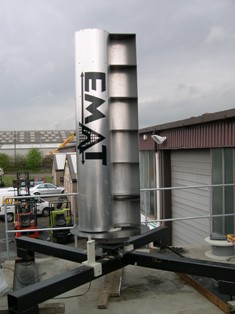Savonius turbine

A low-cost Savonius turbine for domestic use developed by EMAT Ltd, of Gateshead, England.
The Savonius turbine is one of two main types of vertical-axis wind turbine (VAWT); the other is the Darrieus turbine. Invented in Finland in the 1922 by Sigurd J. Savonius, the Savonius turbine is S-shaped if viewed from above, and has two, three, or more scoops to catch the wind. Although, unlike the Darrieus turbine (which uses airfoils and aerodynamic lift to turn the blades), the Savonius turbine can't rotate faster than the speed of the wind, it does yield a high torque.
It is useful for grinding grain, pumping water, and many other tasks, but its slow rotational speeds make it unsuitable for generating electricity on a large-scale. Small electricity-producing Savonius turbines for domestic use, however, such as the one shown here, have been developed.
Advantages
Disadvantage
